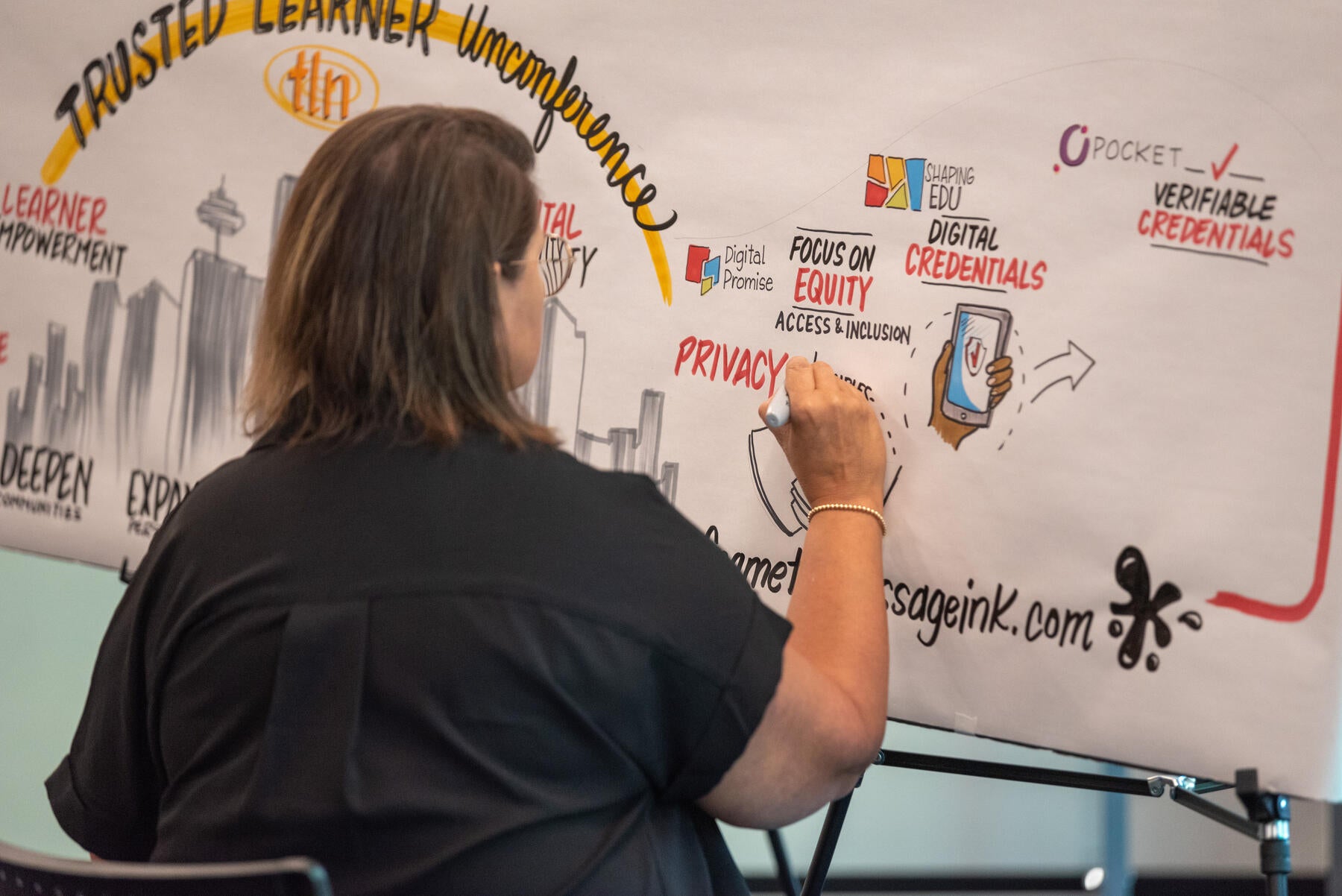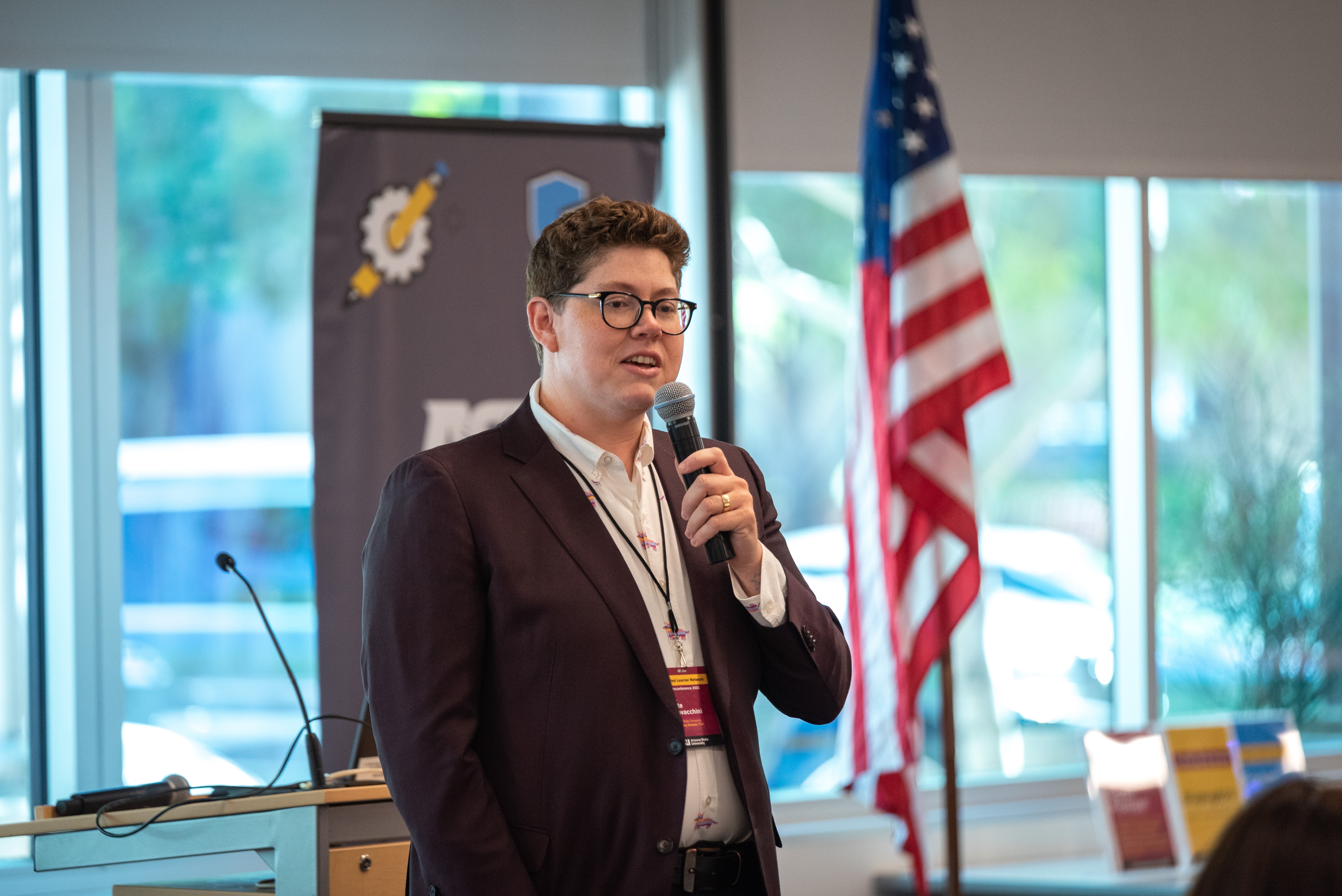
TLN Unconference explores how to make digital credentials more accessible and applicable
Think about the credentials that you’ve received in your life. Your high school diploma. Certificates you’ve earned. Badges of achievement. Now ask yourself, where is the evidence of those accomplishments right now?
Perhaps they’re hanging on a wall in your home or the credit hours are filed in an institutions’ registrar’s office. For most, the process isn’t easily accessible: What would you need to do to gather and share those credentials? How many sources would you need to reach out to? How long might you have to wait? What proof might be required?
“We all spend a lot of money and time in your life on education and achieving new things so that you can move forward, grow and become a better person,” said Kate Giovacchini, Managing Director of ASU’s Trusted Learner Network (TLN). The TLN is designed to make credentials — markers of what you’ve accomplished in your life through formal and informal learning experiences — more accessible and, in turn, more valuable.
“Technologies exist that could potentially make those credentials more functional than they are now,” said Giovacchini. “We have a huge opportunity to breathe new life into them and increase the value of that currency.”
Led by Giovacchini, the TLN is working to reimagine the complex regulatory, technical and economic factors that govern the way that credentials are created, shared and valued. By doing so, learners and earners will be able to unlock opportunities to improve credential mobility, credit transfer and college completion, as well as create new ways for people to express their accomplishments and present themselves.
In May 2022, Giovacchini gathered the TLN community — more than 100 technologists and educators from across universities, community colleges, K-12, non-profits, foundations and governments – in Scottsdale, Arizona for the third TLN Unconference. At the event, attendees had the opportunity to learn from and exchange ideas with some of the top minds in credentialing as the TLN aims to bring digital credentials to the 21st century.
We caught up with Giovacchini to hear more about the TLN’s purpose, what she hopes the community gains from their involvement, key takeaways from the Unconference and more.

Question: In your words, what is the purpose of the Trusted Learner Network?
Kate Giovacchini (KG): At the TLN, we engage with institutions and credential issuers to approach digital credentials from two sides.
On the one hand, we think about governance: what are the rules and best practices that need to be in place in order to make credentials more effective, more mobile and more useful for learners? We’re also thinking a lot about trust. Do you trust that the degree that's on your doctor's wall came from an accredited institution? Why do you trust it and how do we replicate that through the tech? That's an important question in terms of governance.
What the TLN is going to do, on the other hand, is actualize this in a technology that allows institutions and learners to issue, access and control credentials in new ways that break down the silos that currently exist around those credentials.
Q: What problems does the TLN solve for learners and earners?
KG: In addition to those with a college degree, there are 36 million learners with some college or no degree. These learners have earned some college credits, which means that they have made major accomplishments. They've learned new critical skills in subject matter areas that are interesting and valuable to them. But how do they express that accomplishment? How can they share with an employer that they have this valuable knowledge? Especially in a paradigm where having a degree is a yes or no question?
In the job marketplace, it is often very difficult for learners to realize the accomplishment of taking those courses because we don’t have methods for making the finer detail of a course, skill or achievement visible and believable. So, at the TLN, one critical aspect we’re thinking about is how we can help realize value for learners that have some college credits but no degree. We also believe that this can reduce friction for those who would like to go back and continue their learning journey in whatever way makes sense for them, their career and their educational motivations.
Q: What is the landscape of digital credentials in higher education now, and what role does the TLN hope to fill?
KG: One of the challenges — and exciting elements of this digital credential ecosystem – is that there are many players, and there needs to be many critical infrastructures for us to realize the full value. I’ll talk about three — issuers, holders and complementors.
So, you’ll have initiatives from companies that are focused on issuance. How do we empower and enable an organization that generates learning and helps students get degrees? How do we enable them to issue these data rich, valuable credentials?
Then, there are issues around the holder — in our case this is the learner or worker. Say we’ve issued credentials. As a learner, where do I put them, and how do I use them? How do I curate them and then present them again?
Then there is this third piece that I’ll call the complementor piece. Who receives the credential offered by the learner and how do they make sense of it? Somebody is making very important decisions based on this information. We want to create value by saying, “I’m going to hire this person because of this credential, or I need proof of this type of certification in order to hire somebody into this technical field.”
There's work that needs to happen around creating the connections — the sense making — to translate it into something of value, especially outside of the very traditional pathways that we have. We need to broaden these pathways and make room for different iterations.
Within that ecosystem, the role that the TLN fills is the infrastructure piece. We want to create the technology that helps issuers issue digital credentials and learners exert their control over sharing them. We want to create a place where credentials can be pushed into, say, a wallet, or to an employer.
A good way to think about the TLN is as a repository: A place where credentials can be stored and can be used to generate all kinds of value for the people that have earned them.
Q: Thinking about the importance of digital credentials in higher education, what is the purpose of hosting the TLN Unconference?
KG: One of the key design elements of the Trusted Learner Network is the community – one of our core jobs is to coalesce a community around digital credentials and to curate a space where entrepreneurs, educators, evangelists and practitioners can get together and have meaningful conversations about how we move the ecosystem forward.
The reason that that is crucial is because we only realize the true value for learners – for credit, for mobility and for learner agency – when this change reverberates across all our learners. Credits are truly only mobile when a learner can take them from anywhere to anywhere, and effectively utilize them. So it's an ecosystem by nature.
We recognize that and celebrate it by convening this community annually at the Unconference. We curate a space where people can get together, plan, envision and engage around where we need to go as an ecosystem. It’s also an opportunity to update our stakeholder group on the progress of the TLN: where we’re going, what we’ve doing and where we plan to be next.
Q: Ultimately, what is the value of being a member of the TLN community?
KG: Think of it as being an all-access pass to the most brilliant minds, the most effective practitioners, and the big thinkers that are active in this space; those who are trying to figure out how digital credentials can move us forward in employment, in education and toward a more equitable future for all.
Coming together to advance digital credentials for all
At the 2022 TLN Unconference, community members gathered at SkySong in Scottsdale, Arizona to collaborate and innovate about the future of digital credentialing. ASU Chief Information Officer Lev Gonick and ASU Chief Information Security and Digital Trust Officer Donna Kidwell kicked off the event by sharing why emerging credentials are so important in higher education today. Dr. Phillip Long, LER Networker Facilitators + T3 Innovation Network, and Sharon Leu, Executive in Residence for JFFLabs, helped set the scene for the current emerging credentials landscape.
Attendees also had the opportunity to upskill during three workshop sessions featuring a new report from Digital Promise on Learning and Employment Records; exploring ASU’s Pocket, a new portable, secure and verified digital wallet; and learn more about ASU ShapingEDU’s recent Spotlight Mini-Summit: Emerging Credentials x Future Employment, as well as the work of ShapingEDU’s Emerging Credential Standards Action Team.
During the afternoon unconferencing, participants prioritized discussion on five key themes, which were voted on by registrants prior to the event:
- Refining the value proposition of digital credentials for learners and earners.
- Connecting diverse learning experiences and credentials to work and advancement.
- Defining and delivering empowerment for learners and earners
- Evaluating the state of governance, trust and value for learners, issuers and verifiers
- Harnessing digital identity for lifelong learners and their digital credentials.
Interested in becoming a member of the TLN community? Complete the TLN’s interest form to become a partner or to stay informed on upcoming news and events.
In her role at ASU’s University Technology Office, Kate Giovacchini serves as the Managing Director of the Trusted Learner Network and Co-Executive Director of Engineering. Connect with Kate on LinkedIn and Twitter.